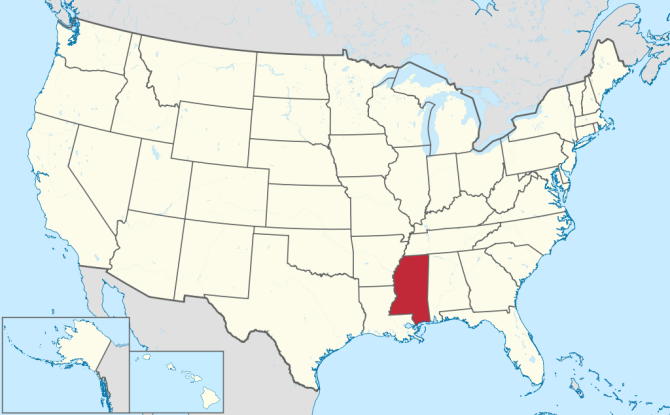| Capital city | Jackson |
| Biggest city | Jackson |
| Surface | 125,443 km² |
| Population | 2,950,000 |
| Length of highway network | 1,406 km |
| First highway | 1960 |
| Abbreviation | MS |
Mississippi is a state in the United States. The state is located in the south of the country and has 2.9 million inhabitants (2021). The capital is Jackson.
Geography
I-20 at Morton, between Jackson and Meridian.
Mississippi is located in the southern United States, on the Gulf of Mexico. It borders the states of Tennessee, Alabama, Louisiana and Arkansas. Stretched in the north-south direction, the state measures 530 kilometers from north to south and 300 kilometers from west to east. Mississippi’s western border is largely formed by the Mississippi River. Also located here is the Mississippi Delta region, which should not be confused with the actual delta of the river in Louisiana. Other rivers are generally small, although the Tennessee River flows in the far northeast of the state.
The state is predominantly densely forested and flat to rolling. The Mississippi Delta region in the northwest of the state has little forest and has many meadows, where cotton was traditionally grown. The 240-foot (246-meter) high Woodall Mountain is the highest point in Mississippi. The south coast of Mississippi is formed by sandy beaches and is urbanized. Several islands and lagoons form the coastline.
The state has a humid subtropical climate with short mild winters and long hot summers. The south is warmer than the north, especially in winter. Precipitation increases from north to south. The average maximum temperature in Jackson is 13°C in winter and 33°C in summer. The state is prone to extreme weather, especially hurricanes from the Gulf of Mexico, powerful tornadoes, and Mississippi River flooding. In 2005, the Mississippi coast was badly damaged by Hurricane Katrina.
Economy
Mississippi is considered the least prosperous state in the country. However, the cost of living is also the lowest in the United States, which somewhat offsets the low income level. The state often scores poorly on indicators such as education and health. The economy is relatively underdeveloped due to the lack of large cities. The state has legalized gambling to generate more income. The main tourist destination is the coast on the Gulf of Mexico, where several coastal cities are located, such as Gulfport, Biloxi and Pascagoula. NASA’s John C. Stennis Space Center is located in the far south of the state.
Demographics
| City | Population |
| Jackson | 150,000 |
| Gulfport | 72,000 |
| south aven | 55,000 |
| Hattiesburg | 46,000 |
| Biloxi | 46,000 |
Population of Mississippi has grown steadily over the centuries, especially in the early 1800s, growing very rapidly, from 7,600 in 1800 to 1.1 million in 1880. Population growth has been much slower and more fluctuating since then. Periods of stagnation or even slight contraction have alternated with periods of stronger growth.
Mississippi has the highest proportion of residents of African descent, more than a third of all residents. The proportion of Hispanics and Asians, on the other hand, is low. The Mississippi Delta in the state’s northwest is often culturally referred to as the southernmost of the south.
History
The first Europeans in Mississippi were Spaniards in the 16th century. The first European settlements in the area were French, starting with Fort Maurepas in 1699. This later became Bilocci and then present-day Biloxi. This was the capital of French America for some time between 1720 and 1723. In 1763 France had to cede the land east of the Mississippi River to the British. After the American Revolution, the area was organized as the Mississippi Territory in 1798. Mississippi became the 20th state of the United States in 1817. In the early 1800s, Mississippi’s economy thrived on lucrative cotton production, particularly in the Mississippi Delta region of the state’s northwest. More than half of the state’s inhabitants at that time were slaves. During the American Civil War, fierce fighting took place over strategically located Vicksburg. In the early 20th century, many African Americans migrated to the industrial cities of the north. Little industry has been developed in the state of Mississippi. The migration of African Americans from the 1930s made them a minority in Mississippi. In 1969, the Mississippi coast was devastated by Hurricane Camille. Similar destruction from Hurricane Katrina followed in 2005.
